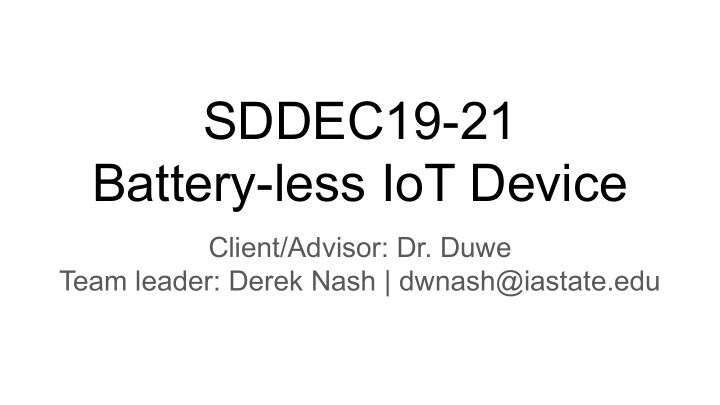



SDDEC19-21 Battery-less IoT Device Client/Advisor: Dr. Duwe Team leader: Derek Nash | dwnash@iastate.edu
Battery-Less IoT Device ● General Problem statement: ○ Harvest RF energy and convert it into a form useable by a microcontroller to perform a useful task ● General Solution Approach: ○ Harvest and convert ambient RF waves into DC ○ Gradual charge and storage (capacitor bank) ○ Low Power Mode Microcontroller ■ Performs a task (reads temperature) ● Outputs data (GPIO)
Conceptual Sketch
Semester Goals ● Prototyping our design ● Testing the functionality of our end product ● Design and assembling our final product on a PCB board ● Delivering a device that harvests ambient RF waves and converts the power received into a usable form.
Technical Challenges - Solved ● Power Circuit Design ○ Mitigating leakage current ■ Solution: smaller capacitor bank ■ .01*C*V = leakage of good capacitor ■ 1/100th the size = 1/100th the leakage ○ Efficient voltage regulation and current (graph) ■ Found better regulator (TLV61224) ● Output 3V instead of 3.3V ● Quiescent current 5uA instead of 65uA ○ Fabricating compact circuits ■ Heat guns, solder paste, flux pens, better solder tips
Technical Challenges - Unsolved ● Power Circuit Design ○ Need a voltage supervisor in front of the regulator ■ Required under discontinuous-power model ■ Enables voltage regulator at 0.8V; disables it at 0.7V Fig: Original Design Fig: New Design
Technical Challenges - Solved ● Antenna ○ Found an antenna that gave similar gain to what we wanted commercially. ● Impedance Matching ○ Test boards have arrived for testing parasitics. We now have a way to measure them.
Technical Challenges - Unsolved ● Antenna ○ Whether the WiFi Router broadcasts enough to charge our capacitor. ● Impedance Matching ○ What will be the loss of efficiency from simulation to real world? ○ Will impedance matching add large amounts of components to the board?
Technical Challenges - Solved ● Embedded Systems ○ Efficiency ■ Interrupt-based data delivery ■ 0.4 μJ per temperature read ○ Data retention and delivery ■ FRAM verified ■ UART-to-serial connectors readily available ● RealTerm, PuTTY, etc.
Technical Challenges - Unsolved ● Embedded Systems ○ Further optimizations ○ Circuit integration ■ Working with Power Circuit team ■ Simple UART connection for user (Serial? USB?)
Questions?
Thank you
Antenna Circuit Figure 01: 2.4 GHz Patch Antenna
Rectifier Circuit Schematic and board of Cockroft-Walton voltage multiplier
Software Control Flow
Recommend
More recommend